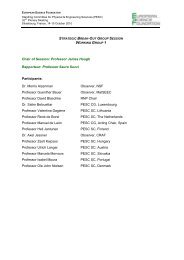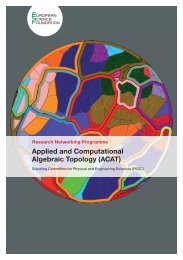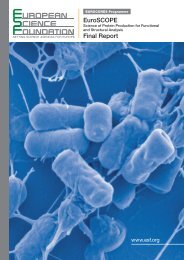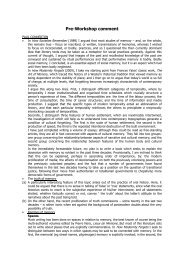Nanomedicine - European Science Foundation
Nanomedicine - European Science Foundation
Nanomedicine - European Science Foundation
Create successful ePaper yourself
Turn your PDF publications into a flip-book with our unique Google optimized e-Paper software.
16<br />
2. CURRENT STATUS OF NANOMEDICINE RESEARCH AND FORWARD LOOK<br />
tion, target selection, local stimulation and potentially<br />
local modification.<br />
Development of more sophisticated imaging<br />
equipment requires an integrated approach. Underpinning<br />
research must involve all aspects of the<br />
process.<br />
Parallel to the development of the analytical<br />
equipment, research and clinical development is<br />
ongoing to provide a new generation of nanoimaging<br />
agents. These include both synthetic nanoparticles<br />
(including dendrimers and polymeric<br />
nanoparticles) and biological nanoparticles (nanoorganisms).<br />
In the future it is likely that these imaging<br />
tools will become ever more complex, multicomponent<br />
systems combining contrast agents and tracking<br />
probes (e.g. quantum dots, magnetic and<br />
superparamagnetic beads, nanoshells and nanocolloids)<br />
with new targeting ligands. For targeted<br />
systems, carriers can be used which may require<br />
additional surface modification, and linkers that<br />
bring additional challenges for physicochemical<br />
characterisation and safety evaluation. In some cases<br />
combination of a range of signal modalities (e.g.<br />
organic dyes) is also used. Imaging and contrast<br />
agent design has a considerable overlap with nanomaterials<br />
and drug delivery system development.<br />
Historically, radiolabelled antibodies have already<br />
been transferred to market as diagnostic tools in<br />
cancer, and in the form of radiolabelled antibodies<br />
and antibody conjugates as a therapeutic agent. It can<br />
be argued that the radiolabelled therapeutic antibody<br />
is the first nanosized theranostic.<br />
Development of molecular imaging diagnostics<br />
is expected to have a major impact on healthcare in<br />
the future and the opportunities are summarised<br />
below.<br />
2.1.3. Workshop on Nanomaterials<br />
and Nanodevices<br />
Workshop participants:<br />
Prof. Jeffrey Alan Hubbell, Prof. Ruth Duncan<br />
(chairs), Prof. Wim Hennink,<br />
Prof. Helmut Ringsdorf (co-chairs),<br />
Prof. Hans Börner, Prof. João Pedro Conde,<br />
Dr John W Davies, Prof. Harm-Anton Klok,<br />
Prof. Helmuth Möhwald, Dr Mihail Pascu,<br />
Prof. José Rivas, Dr Christoph Steinbach,<br />
Prof. Manuel Vázquez, Dr Peter Venturini,<br />
Dr Petra Wolff, Prof. Andrew McCaskie<br />
Molecular Imaging Diagnostics (MDx): Impact on healthcare in the future<br />
Genetic<br />
disposition<br />
DNA<br />
mutations<br />
Developing<br />
molecular<br />
signature<br />
First<br />
symptoms<br />
Progressing<br />
disease<br />
© Philips<br />
Future<br />
Today<br />
Earlier diagnosis,<br />
optimized workflow<br />
Screening<br />
• Unspecific<br />
markers<br />
• POC<br />
imaging<br />
• Mammography<br />
Diagnosis<br />
& Staging<br />
• Diagnostic<br />
imaging<br />
• Biopsies<br />
Treatment &<br />
Monitoring<br />
• Surgery<br />
• Cath-lab<br />
• Radiation<br />
therapy<br />
Followup<br />
• Diagnostic<br />
imaging<br />
• Unspecific<br />
markers<br />
Screening<br />
Diagnosis<br />
& Staging<br />
Treatment &<br />
Monitoring<br />
Followup<br />
• Specific<br />
markers<br />
(MDx)<br />
• Molecular<br />
imaging:<br />
quantitative,<br />
whole-body<br />
• CA Diagnosis<br />
• Mini-invasive<br />
surgery<br />
• Local/targeted<br />
drug<br />
delivery &<br />
tracing<br />
• Tissue analysis<br />
(MDx)<br />
• MI, MDx<br />
• Non-invasive,<br />
Quantitative<br />
imaging

















